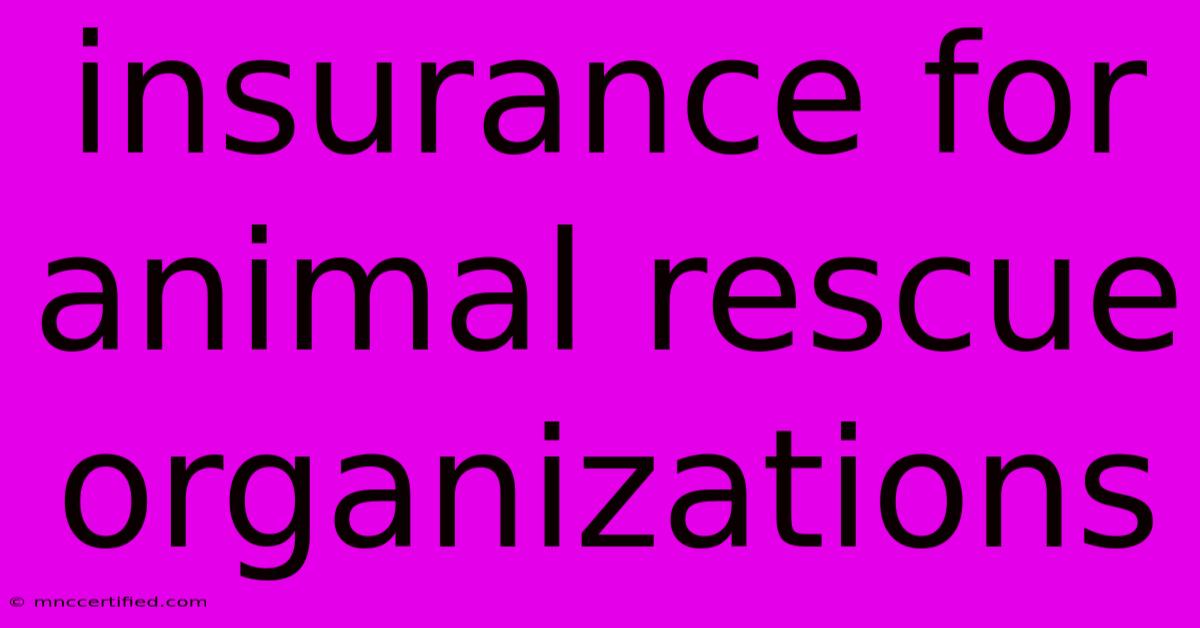Insurance For Animal Rescue Organizations

Table of Contents
Protecting Your Mission: Insurance for Animal Rescue Organizations
Animal rescue organizations are driven by a passion for saving lives. But running a rescue operation involves significant financial and legal risks. Insurance is an essential tool for safeguarding your organization and ensuring its long-term sustainability.
This article will guide you through the crucial types of insurance for animal rescue organizations, highlighting their importance and helping you navigate the complex world of coverage.
Why Insurance is Crucial for Animal Rescue Organizations
Liability is a major concern. You could face lawsuits if an animal you care for causes damage or injury. Protecting your volunteers is also vital. They may face risks while handling animals, transporting them, or working in various environments. Property damage and theft are potential hazards, especially if you operate from a shelter or facility.
Furthermore, insurance can protect your financial resources. Accidents, illnesses, or legal claims could cripple your organization financially, hindering your ability to continue rescuing animals.
Key Types of Insurance for Animal Rescue Organizations
Here are the essential insurance policies for animal rescue organizations:
1. General Liability Insurance: This is the foundation of any rescue organization's insurance plan. It covers claims of bodily injury or property damage caused by your organization's activities or the animals in your care.
2. Workers' Compensation Insurance: This is crucial for protecting volunteers and paid staff from injuries or illnesses incurred while performing rescue duties.
3. Property Insurance: This covers damage to your shelter, facility, and equipment from events like fire, theft, vandalism, or natural disasters.
4. Animal Liability Insurance: This specific policy addresses liability claims related to injuries or damage caused by animals in your care. It covers incidents like bites, scratches, or property damage.
5. Directors and Officers Liability Insurance (D&O): This policy protects board members and officers from personal liability arising from decisions made in their official capacity.
6. Professional Liability Insurance: This insurance is vital if your organization provides veterinary services or animal training. It covers claims of negligence or malpractice.
7. Cyber Liability Insurance: In today's digital world, this policy is critical. It protects your organization from data breaches, cyberattacks, and privacy violations.
Tips for Choosing the Right Insurance
- Evaluate your specific needs: Different organizations have different needs. Analyze your operations, the types of animals you handle, your facility, and your volunteer/staff structure.
- Consult with insurance brokers: They can help you assess your risks and recommend appropriate policies and coverage levels.
- Consider your budget: Explore different insurance providers and compare quotes. Look for affordable options that provide adequate coverage.
- Review your policies regularly: Update your policies as your organization grows, changes its operations, or faces new risks.
Additional Considerations
- Volunteer agreements: Ensure all volunteers sign agreements acknowledging risks and releasing your organization from certain liabilities.
- Safety protocols: Implement clear safety protocols for handling animals, transporting them, and operating your facility.
- Fundraising and marketing: Highlight your commitment to responsible animal care and your insurance coverage to potential donors and supporters.
Investing in insurance is a responsible and essential step for any animal rescue organization. It protects your mission, safeguards your financial resources, and allows you to continue rescuing animals with peace of mind. By understanding the types of insurance available and choosing the right policies, you can build a strong foundation for your organization's success and impact.

Thank you for visiting our website wich cover about Insurance For Animal Rescue Organizations. We hope the information provided has been useful to you. Feel free to contact us if you have any questions or need further assistance. See you next time and dont miss to bookmark.
Featured Posts
-
Health Insurance For Wisdom Teeth Removal
Nov 07, 2024
-
Insurance Distribution Directive Training
Nov 07, 2024
-
Will Medical Insurance Cover Oral Surgery
Nov 07, 2024
-
Professional Liability Insurance Colorado
Nov 07, 2024
-
Filing A Lawsuit Against Insurance Company
Nov 07, 2024